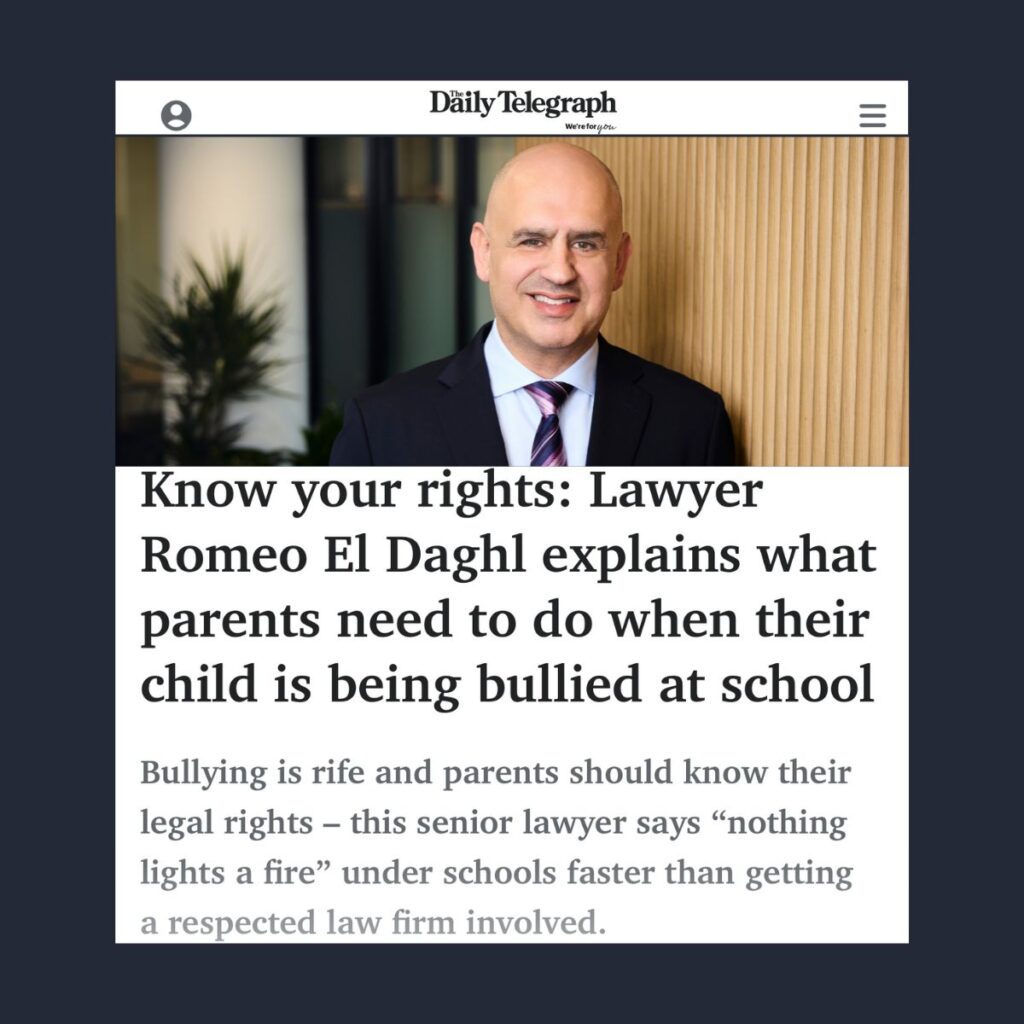Q&A with Lawpoint Principal, Romeo El Daghl
This week marks Bullying No Way Week, a national initiative to raise awareness and drive action on how to stop bullying at school and keep children safe.
Over the weekend, our principal lawyer, Romeo El-Daghl, was featured across News Corp publications, including the Daily Telegraph, sharing crucial information about what parents can do if their child is being bullied and what schools are legally required to do to protect them.
Read the full Daily Telegraph article here – subscription required → https://bit.ly/4lotEM2

In this extended Q&A, Romeo answers the questions we’re most often asked by parents, covering:
- How to stop bullying at school and protect your child
- Your child’s legal rights if they’re bullied
- A school’s duty of care (including cyberbullying)
- When and how legal action can be taken
- Common mistakes to avoid when responding to bullying
Romeo has acted for countless families in bullying matters, from helping parents secure urgent interventions to running a complex school bullying compensation claim in court.
He is a big believer in settling matters wherever possible and where it makes sense for the family, recognising that early resolution can often deliver better emotional and practical outcomes for children.

How to stop bullying at school - what rights do parents have? What legal action is available?
Parents have the right to expect that their child is safe at school. Schools have a duty to take reasonable care to prevent students from suffering physical and psychological harm, including harm caused by other students.
Parents have the right to expect that their child is safe at school. Schools have a duty to take reasonable care to prevent students from suffering physical and psychological harm. This includes harm caused by other students. Importantly, this duty of care is non-delegable, meaning schools can’t pass the responsibility on. They must take active steps to keep students safe.
If a school isn’t responding adequately to complaints, parents can and should utilise available complaint pathways to escalate their concerns. This can include lodging complaints via the school’s official complaint handling policies or contacting the relevant authority such as the Department of Education for public schools, or the governing body or diocese for private and non-government schools.
Where those complaints do not resolve the issue, parents can engage a lawyer to step in. Not to escalate the dispute, but to ensure the school is taking its legal obligations seriously, adhering to applicable policies.
This kind of legal intervention is particularly valuable when parents feel they’ve exhausted all internal pathways. Legal intervention can prompt appropriate interventions by schools to prevent ongoing bullying and reduce the risk of further psychological harm to the student.
If serious harm to a student has already occurred, a student can sue the responsible school body. A successful claim can provide much needed financial assistance to compensate for the damage suffered and, equally importantly, can provide validation for the student and their family. The psychological benefit of being seen, heard and vindicated should not be underestimated.
How successful has legal action been in the past to stop bullying?
Most bullying claims against schools are settled, often because of reputational concerns, particularly with private schools. Legal intervention can be very effective both in achieving compensation and prompting effective school action.
Measuring the effectiveness of legal action in terms of publicly available information is difficult because most bullying claims against schools are settled. This is not surprising, particularly with private schools, given the likely reputational damage that can flow from a public judgment. Schools tend to dislike headlines that involve both their name and the phrase “breach of duty”.
However, in my experience, legal intervention is often very effective, not just in terms of compensation, but in being the catalyst for effective action by schools. We’ve seen time and again that once a lawyer is involved, schools and governing bodies take matters more seriously and act faster to resolve them. Few things light a fire under policy compliance like legal letterhead.
In terms of compensation claims, they are difficult to run, involve complex legal concepts and are often fought very hard by schools and their insurers. However, there is now well settled legal authority in Australia that makes such cases winnable if a breach of the duty can be established and where a student has suffered harm as a result. I have handled many bullying cases both for compensation and also on behalf of parents seeking effective action from schools to the bullying of their child. Only one compensation case proceeded to judgment, which was a judgment in favour of the student we acted for. Others have been settled after legal proceedings were commenced or without the need to commence proceedings at all.
It’s important to note though that by the time a case gets to court, the student has already suffered serious harm, which will likely continue well into adulthood. No legal outcome can undo that. A parent’s goal should always be to intervene early, stop the harm and avoid litigation wherever possible. That is certainly our goal, too.
What are a school’s legal obligations in preventing bullying?
Schools have a non-delegable duty of care to take reasonable steps to prevent students suffering physical and psychological harm, including harm from other students. This duty can extend beyond school hours and school grounds, particularly in cases of cyberbullying.
Schools have a non-delegable duty of care to take reasonable steps to prevent students suffering physical and psychological harm. This duty extends to taking reasonable care to prevent harm from other students.
It is very important to note that a school’s duty isn’t just limited to a duty to prevent harm during school hours or within the confines of the school. In recent times, Australian courts have recognised that this duty can, in certain circumstances, extend beyond school hours and school grounds, which is especially relevant to the pervasive issue of cyberbullying.
That means a few things:
- Taking all bullying complaints seriously. Outdated responses like “toughen up” or “ignore it” are unacceptable and are likely to worsen the harm.
- Recognising that different students have different vulnerabilities. Just because one student is unaffected by name calling does not mean that another student will not be substantially affected by it. There is no such thing as a “normal” reaction to bullying.
- Early intervention is critical. A failure to intervene emboldens bullies to continue to engage in the harmful conduct. In turn, that can result in more serious and in some instances, irreversible harm, being suffered by victims.
- Have proper anti-bullying and student welfare policies in place. This means well thought out, evidence-based policies, not pro forma documents prepared as a box ticking exercise.
- Following their own policies. Every school in Australia has an anti-bullying policy, but we regularly see them ignored or misapplied. Proper training of school staff is essential. Staff must be aware of the policies and able to effectively identify and respond to bullying.
- Regularly review bullying policies rather than adopting a ‘set and forget’ approach. Schools should assess the effectiveness of their policies and make changes where required.
- Make sure students know about the policies and how they can report bullying. One study of 26 schools found that although all 26 schools reported having a written anti-bullying policy, less than 50% of students were aware of it.
- Pay particular attention to complaints by vulnerable students, who’s risk of harm is higher. A school’s duty to prevent harm is even more important where the student involved is a vulnerable person, such as a neurodiverse student or one with a disability.
- Respond to bullying that happens online or outside of school hours. It is highly unlikely that bullying stops at the school gates. If students are engaging in harmful behaviour towards other students on social media or in chat groups outside of school, chances are that they are engaging in the same behaviour towards the victim when they are all at school together.
What constitutes a breach of duty and how hard is it to prove?
A bullying claim requires establishing a duty of care, proving that duty was breached, and showing that the breach caused the student’s loss.
In simplified terms, such a claim necessarily involves three components:
(a) Establishing the existence of a duty of care;
(b) Establishing a breach of that duty; and
(c) Establishing that the breach of duty was causative of the student’s loss.
There is little doubt that schools owe students a non-delegable duty of care to prevent against a risk of harm to a student. The risk of harm must be foreseeable and not insignificant. Despite outdated notions that persist in some schools, especially private boys’ schools where concepts of masculinity have been long left behind by societal changes, there is an undeniable body of scientific evidence establishing the causal link between bullying and serious psychiatric and psychological harm to children (and adults).
A more complex question is the scope of that duty, for example, whether the duty extends to acts occurring outside of school at a bus stop or to certain types of conduct.
Establishing the breach of duty will be determined by reference to the individual facts of a matter. Relevant matters that require proof are:
- That the child was bullied and the types of conduct that he/she was subjected to;
- That the school knew or should have known about the bullying;
- That the school failed to act appropriately or at all;
- That the failure caused a foreseeable risk of harm which was not insignificant, to materialise;
- The child suffered a physical injury or in the case of psychological injury, the child suffered a recognised psychiatric illness; and
- That injury resulted in the student suffering loss or damage.
School bullying cases are legally complex and emotionally fraught. They are often fought hard by school insurers with deep pockets keen to avoid precedents being set. However, with the right legal support, they are not insurmountable.
What sort of financial outlay would legal action require?
Costs depend on the approach. Engaging a lawyer to ensure the school responds appropriately is generally low-cost, while court claims are more expensive and complex.
Some parents engage a lawyer to help ensure the school is responding appropriately to complaints and taking action to ensure the safety of their child. In this case, costs are generally relatively low and legal intervention is often effective in a short period. Rates differ but there are legal aid options for families if they cannot afford to pay for a private lawyer.
Court claims involve significantly more work and therefore significantly higher cost. Overall costs will depend on the complexity of the case and the issues it involves and at what stage of the matter an outcome is achieved. Cases can take several years to resolve however this is often on a no win no fee basis – therefore with no upfront cost to the family.
Lawpoint offers no win, no fee arrangements for bullying compensation claims, to help ensure access to justice isn’t determined by financial means.
What supports are available to parents who struggle financially?
Parents may be eligible for Legal Aid, community legal centre assistance, or Lawpoint’s no win, no fee arrangements for compensation claims.
Parents may be eligible for Legal Aid, depending on their circumstances. Some community legal centres also offer support. At Lawpoint, in the case of compensation claims, our no win, no fee model provides another option for families who need legal help but are concerned about upfront costs.
What are the things a parent must avoid?
Parents should avoid acting out of anger, confronting children directly, venting publicly on social media, or making complaints without proper documentation.
This is perhaps the most overlooked part of the equation.
Understandably, parents feel outraged when their child is bullied. But acting out of anger can harm negotiations and unintentionally, their child’s outcome. We’ve seen negotiations break down because school staff take issue with the parents’ conduct and unfortunately, it’s their child who pays the price.
Unless there is some imminent danger to their child that requires urgent intervention, parents should never approach a child directly about bullying behaviour. It may be possible to approach the child’s parents, but this is generally only wise if they have a constructive, pre-existing relationship and it is done in respectful way. It’s important to remember that the parents may not be aware of the conduct that their child is alleged to have engaged in.
Social media rants and even venting in the parents WhatsApp group can have legal consequences. It is never advisable to name or post a picture of a child and name and shame them or their parents for alleged bullying behaviour. Trial by social media may feel good, but it can often prove costly, especially if the content is defamatory.
Parents should also avoid situations where they do not have evidence of their complaints. This means carefully documenting all complaints made to the school. The best approach is to put complaints in writing or following up verbal conversations with an email, confirming the nature of the complaint made during that meeting. Be as detailed as possible-what exactly is the conduct being complained of, when did it occur, who is the perpetrator and what effect has it had on their child. This detail may be important and powerful evidence if a claim is later brought against the school.
The most powerful thing parents can do is stay calm, stay respectful and stay focused on the end goal: creating a safe environment for their child. That mindset – rather than one of assigning blame or launching a slandering campaign against the offender or school – often leads to the best outcome.



